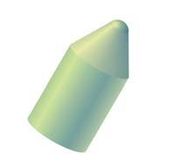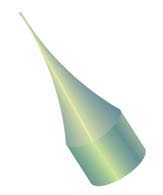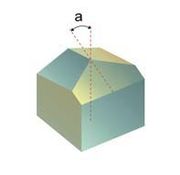
Nanoindenter
Encyclopedia
A nanoindenter is the main component for indentation hardness tests used in nanoindentation
. Since the mid 1970’s nanoindentation has become the primary method for measuring and testing very small volumes of mechanical properties. Nanoindentation, also called depth sensing indentation or instrumented indentation, gained popularity with the development of machines that could record small load and displacement with high accuracy and precision. The load displacement data can be used to determine modulus of elasticity, hardness, yield strength, fracture toughness
, scratch hardness and wear properties.


 There are many types of nanoindenters in current use differing mainly on their tip geometry. Among the numerous available geometries are three and four sided pyramids
There are many types of nanoindenters in current use differing mainly on their tip geometry. Among the numerous available geometries are three and four sided pyramids
, wedges
, cones
, cylinders
, filaments, and sphere
s. Several geometries have become a well established common standard due to their extended use and well known properties; such as Berkovich, cube corner, Vickers, and Knoop nanoindenters. To meet the high precision required, nanoindenters must be made following the definitions of ISO 14577-2, and be inspected and measured with equipment and standards traceable to the National Institute of Standards and Technology
(NIST). The tip end of the indenter can be made sharp, flat, or rounded to a cylindrical or spherical shape. The material for most nanoindenters is diamond
and sapphire
, although other hard materials can be used such as quartz
, silicon
, tungsten
, steel
, tungsten carbide
and almost any other hard metal or ceramic material. Diamond is the most commonly used material for nanoindentation due to its properties of hardness, thermal conductivity
, and chemical inertness. In some cases electrically conductive diamond may be needed for special applications and is also available.
, machinable ceramic, other metals or rigid materials. In most cases the indenter is attached to the holder using a rigid metal bonding process. The metal forms a molecular bond with both material be it diamond-steel, diamond-ceramic, etc.
s or comparators
are neither practical nor precise enough to measure nanoindenter angles even with help of microscope
s. For precise measurements a laser
goniometer
is used to measure diamond nanoindenter angles. Nanoindenter faces are highly polished and reflective which is the basis for the laser goniometer measurements. The laser goniometer can measure within a thousandth of a degree to specified or requested angles.
Nanoindentation
Nanoindentation is a variety of indentation hardness tests applied to small volumes. Indentation is perhaps the most commonly applied means of testing the mechanical properties of materials...
. Since the mid 1970’s nanoindentation has become the primary method for measuring and testing very small volumes of mechanical properties. Nanoindentation, also called depth sensing indentation or instrumented indentation, gained popularity with the development of machines that could record small load and displacement with high accuracy and precision. The load displacement data can be used to determine modulus of elasticity, hardness, yield strength, fracture toughness
Fracture toughness
In materials science, fracture toughness is a property which describes the ability of a material containing a crack to resist fracture, and is one of the most important properties of any material for virtually all design applications. The fracture toughness of a material is determined from the...
, scratch hardness and wear properties.
Types



Pyramid (geometry)
In geometry, a pyramid is a polyhedron formed by connecting a polygonal base and a point, called the apex. Each base edge and apex form a triangle. It is a conic solid with polygonal base....
, wedges
Wedge (geometry)
In solid geometry, a wedge is a polyhedron defined by two triangles and three trapezoid faces. A wedge has five faces, nine edges, and six vertices.A wedge is a subclass of the prismatoids with the base and opposite ridge in two parallel planes....
, cones
Cone (geometry)
A cone is an n-dimensional geometric shape that tapers smoothly from a base to a point called the apex or vertex. Formally, it is the solid figure formed by the locus of all straight line segments that join the apex to the base...
, cylinders
Cylinder (geometry)
A cylinder is one of the most basic curvilinear geometric shapes, the surface formed by the points at a fixed distance from a given line segment, the axis of the cylinder. The solid enclosed by this surface and by two planes perpendicular to the axis is also called a cylinder...
, filaments, and sphere
Sphere
A sphere is a perfectly round geometrical object in three-dimensional space, such as the shape of a round ball. Like a circle in two dimensions, a perfect sphere is completely symmetrical around its center, with all points on the surface lying the same distance r from the center point...
s. Several geometries have become a well established common standard due to their extended use and well known properties; such as Berkovich, cube corner, Vickers, and Knoop nanoindenters. To meet the high precision required, nanoindenters must be made following the definitions of ISO 14577-2, and be inspected and measured with equipment and standards traceable to the National Institute of Standards and Technology
National Institute of Standards and Technology
The National Institute of Standards and Technology , known between 1901 and 1988 as the National Bureau of Standards , is a measurement standards laboratory, otherwise known as a National Metrological Institute , which is a non-regulatory agency of the United States Department of Commerce...
(NIST). The tip end of the indenter can be made sharp, flat, or rounded to a cylindrical or spherical shape. The material for most nanoindenters is diamond
Diamond
In mineralogy, diamond is an allotrope of carbon, where the carbon atoms are arranged in a variation of the face-centered cubic crystal structure called a diamond lattice. Diamond is less stable than graphite, but the conversion rate from diamond to graphite is negligible at ambient conditions...
and sapphire
Sapphire
Sapphire is a gemstone variety of the mineral corundum, an aluminium oxide , when it is a color other than red or dark pink; in which case the gem would instead be called a ruby, considered to be a different gemstone. Trace amounts of other elements such as iron, titanium, or chromium can give...
, although other hard materials can be used such as quartz
Quartz
Quartz is the second-most-abundant mineral in the Earth's continental crust, after feldspar. It is made up of a continuous framework of SiO4 silicon–oxygen tetrahedra, with each oxygen being shared between two tetrahedra, giving an overall formula SiO2. There are many different varieties of quartz,...
, silicon
Silicon
Silicon is a chemical element with the symbol Si and atomic number 14. A tetravalent metalloid, it is less reactive than its chemical analog carbon, the nonmetal directly above it in the periodic table, but more reactive than germanium, the metalloid directly below it in the table...
, tungsten
Tungsten
Tungsten , also known as wolfram , is a chemical element with the chemical symbol W and atomic number 74.A hard, rare metal under standard conditions when uncombined, tungsten is found naturally on Earth only in chemical compounds. It was identified as a new element in 1781, and first isolated as...
, steel
Steel
Steel is an alloy that consists mostly of iron and has a carbon content between 0.2% and 2.1% by weight, depending on the grade. Carbon is the most common alloying material for iron, but various other alloying elements are used, such as manganese, chromium, vanadium, and tungsten...
, tungsten carbide
Tungsten carbide
Tungsten carbide is an inorganic chemical compound containing equal parts of tungsten and carbon atoms. Colloquially, tungsten carbide is often simply called carbide. In its most basic form, it is a fine gray powder, but it can be pressed and formed into shapes for use in industrial machinery,...
and almost any other hard metal or ceramic material. Diamond is the most commonly used material for nanoindentation due to its properties of hardness, thermal conductivity
Thermal conductivity
In physics, thermal conductivity, k, is the property of a material's ability to conduct heat. It appears primarily in Fourier's Law for heat conduction....
, and chemical inertness. In some cases electrically conductive diamond may be needed for special applications and is also available.
Holders
Nanoindenters are mounted on holders which could be the standard design from a manufacturer of nanoindenting equipment, or custom design. The holder material can be steel, titaniumTitanium
Titanium is a chemical element with the symbol Ti and atomic number 22. It has a low density and is a strong, lustrous, corrosion-resistant transition metal with a silver color....
, machinable ceramic, other metals or rigid materials. In most cases the indenter is attached to the holder using a rigid metal bonding process. The metal forms a molecular bond with both material be it diamond-steel, diamond-ceramic, etc.
Angular measurements
Nanoindenter dimensions are very small, some less than 50 um, and made with precise angular geometry in order to achieve the highly accurate readings required for nanoindentation. Instruments that measure angles on larger objects such as protractorProtractor
In geometry, a protractor is a circular or semicircular tool for measuring an angle or a circle. The units of measurement utilized are usually degrees.Some protractors are simple half-discs; these have existed since ancient times...
s or comparators
Optical comparator
An optical comparator is a device that applies the principles of optics to the inspection of manufactured parts...
are neither practical nor precise enough to measure nanoindenter angles even with help of microscope
Microscope
A microscope is an instrument used to see objects that are too small for the naked eye. The science of investigating small objects using such an instrument is called microscopy...
s. For precise measurements a laser
Laser
A laser is a device that emits light through a process of optical amplification based on the stimulated emission of photons. The term "laser" originated as an acronym for Light Amplification by Stimulated Emission of Radiation...
goniometer
Goniometer
A goniometer is an instrument that either measures an angle or allows an object to be rotated to a precise angular position. The term goniometry is derived from two Greek words, gōnia, meaning angle, and metron, meaning measure....
is used to measure diamond nanoindenter angles. Nanoindenter faces are highly polished and reflective which is the basis for the laser goniometer measurements. The laser goniometer can measure within a thousandth of a degree to specified or requested angles.

